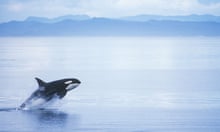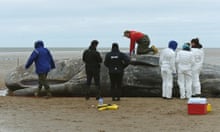Two more public figures passed on last week: an impressive centenarian and community leader; and a killer serving life imprisonment. They taught us about one of the planet’s most intelligent creatures, and our own capacity for love and cruelty.
Granny, the matriarch of a wild orca population close to Vancouver and Seattle, may have been as old as 105. She was studied for 40 years as researchers unravelled why orcas are one of only three mammals – with short-finned pilot whales and us – known to experience the menopause. Orca matriarchs, scientists learned, have a crucial role in guiding a pod, taking care of other females’ calves, and even feeding adult males.
Granny was also a symbol of freedom during the most disastrous period of human-cetacean relations, dodging the “capture kings” of the 1960s and 70s who grabbed hundreds of killer whales and placed them in aquariums for our amusement.
Tilikum embodied this cruelty. Snatched from Icelandic waters aged two as recently as 1983, he was transported first to a Canadian marine park and then to SeaWorld in the US. One former trainer estimates this impressive alpha male was the largest cetacean ever to be held in captivity.
In one of the most carefully worded obituaries ever written, SeaWorld paid tribute to 36-year-old Tilikum’s “long and enriching life”. It was “long” by the standards of captivity: analysis of 201 captive orcas found a median survival of just 6.1 years. And the “enrichment” must refer to the human pleasure taken from inspiring encounters with this caged beast.
For Tilikum felt and also inflicted great pain. While in captivity, he was implicated in the deaths of three humans, including his trainer, Dawn Brancheau, in 2010.
One hundred million people have watched Blackfish, the documentary about Tilikum that takes the basic premise that if you were taken from your mother and reduced to a life chewing a concrete cage, you might become slightly psychotic. The film sparked a boycott of SeaWorld, and last year the “theatrical killer whale experience” at its San Diego park closed. Orca entertainments continue at other SeaWorld parks, but the theme park operator has, crucially, ended its captive breeding programme. Animal welfare groups want to release its orcas into sea pens, but there’s no sign of that yet.
Granny’s group of wild orcas number just 71 now, depleted by the capture-kings, marine traffic and pollution. Britain’s resident orca clan hasn’t sired a calf for 20 years: scientists blame pollution for this infertility. We are still far from making the wild a haven for these magnificent animals, as it should be.
Where whales envy insects
Is France a utopia for citizens seeking a repaired relationship with nature? It has banned pesticides from gardens and parks to stop us poisoning the insects that support life; and supermarket food waste is unlawful, as is fracking. But dystopian elements remain. France is home to Marineland, where captive orcas still perform tricks and two died in 2015. If orcas were as slow to adapt as corporate marine parks, they would be extinct by now.
The Wally of Norfolk
At least marine mammals are on the march near my home in Norfolk. Grey seals have bred at Horsey Gap in record numbers, and one was recently found in a garden in Blakeney – 2km from the sea – lost but healthy. Seals have long followed rivers to find fish: in 1931 Billy the seal took up residence in Wereham village pond. In 1981 a garden near Downham Market became home to a walrus who swam up the river. Inevitably, it was named Wally.









